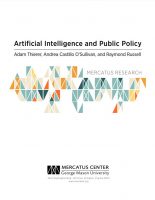By Brent Skorup and Melody Calkins
Tech-optimists predict that drones and small aircraft may soon crowd US skies. An FAA administrator predicted that by 2020 tens of thousands of drones would be in US airspace at any one time. Further, over a dozen companies, including Uber, are building vertical takeoff and landing (VTOL) aircraft that could one day shuttle people point-to-point in urban areas. Today, low-altitude airspace use is episodic (helicopters, ultralights, drones) and with such light use, the low-altitude airspace is shared on an ad hoc basis with little air traffic management. Coordinating thousands of aircraft in low-altitude flight, however, demands a new regulatory framework.
Why not auction off low-altitude airspace for exclusive use?
There are two basic paradigms for resource use: open access and exclusive ownership. Most high-altitude airspace is lightly used and the open access regime works tolerably well because there are a small number of players (airline operators and the government) and fixed routes. Similarly, Class G airspace—which varies by geography but is generally the airspace from the surface to 700 feet above ground—is uncontrolled and virtually open access.
Valuable resources vary immensely in their character–taxi medallions, real estate, radio spectrum, intellectual property, water–and a resource use paradigm, once selected requires iteration and modification to ensure productive use. “The trick,” Prof. Richard Epstein notes, “is to pick the right initial point to reduce the stress on making these further adjustments.” If indeed dozens of operators will be vying for variable drone and VTOL routes in hundreds of local markets, exclusive use models could create more social benefits and output than open access and regulatory management. NASA is exploring complex coordination systems in this airspace but, rather than agency permissions, lawmakers should consider using property rights and the price mechanism.
The initial allocation of airspace could be determined by auction. An agency, probably the FAA, would:
- Identify and define geographic parcels of Class G airspace;
- Auction off the parcels to any party (private corporations, local governments, non-commercial stakeholders, or individual users) for a term of years with an expectation of renewal; and
- Permit the sale, combination, and subleasing of those parcels
The likely alternative scenario—regulatory allocation and management of airspace–derives from historical precedent in aviation and spectrum policy:
- First movers and the politically powerful acquire de facto control of low-altitude airspace,
- Incumbents and regulators exclude and inhibit newcomers and innovators,
- The rent-seeking and resource waste becomes unendurable for lawmakers, and
- Market-based reforms are slowly and haphazardly introduced.
For instance, after demand for commercial flights took off in the 1960s, a command-and-control quota system was created for crowded Northeast airports. Takeoff and landing rights, called “slots,” were assigned to early airlines but regulators did not allow airlines to sell those rights. The anticompetitive concentration and hoarding of airport slots at terminals is still being slowly unraveled by Congress and the FAA to this day. There’s a similar story for government assignment of spectrum over decades, as explained in Thomas Hazlett’s excellent new book, The Political Spectrum.
The benefit of an auction, plus secondary markets, is that the resource is generally put to its highest-valued use. Secondary markets and subleasing also permit latecomers and innovators to gain resource access despite lacking an initial assignment and political power. Further, exclusive use rights would also provide VTOL operators (and passengers) the added assurance that routes would be “clear” of potential collisions. (A more regulatory regime might provide that assurance but likely via complex restrictions on airspace use.) Airspace rights would be a new cost for operators but exclusive use means operators can economize on complex sensors, other safety devices, and lobbying costs. Operators would also possess an asset to sublease and monetize.
Another bonus (from the government’s point of view) is that the sale of Class G airspace can provide government revenue. Revenue would be slight at first but could prove lucrative once there’s substantial commercial interest. The Federal government, for instance, auctions off its usage rights for grazing, oil and gas retrieval, radio spectrum, mineral extraction, and timber harvesting. Spectrum auctions alone have raised over $100 billion for the Treasury since they began in 1994.
 The Mercatus Center at George Mason University has just released a new paper on, “Artificial Intelligence and Public Policy,” which I co-authored with Andrea Castillo O’Sullivan and Raymond Russell. This 54-page paper can be downloaded via the Mercatus website, SSRN, or ResearchGate. Here is the abstract:
The Mercatus Center at George Mason University has just released a new paper on, “Artificial Intelligence and Public Policy,” which I co-authored with Andrea Castillo O’Sullivan and Raymond Russell. This 54-page paper can be downloaded via the Mercatus website, SSRN, or ResearchGate. Here is the abstract:



 The Technology Liberation Front is the tech policy blog dedicated to keeping politicians' hands off the 'net and everything else related to technology.
The Technology Liberation Front is the tech policy blog dedicated to keeping politicians' hands off the 'net and everything else related to technology.